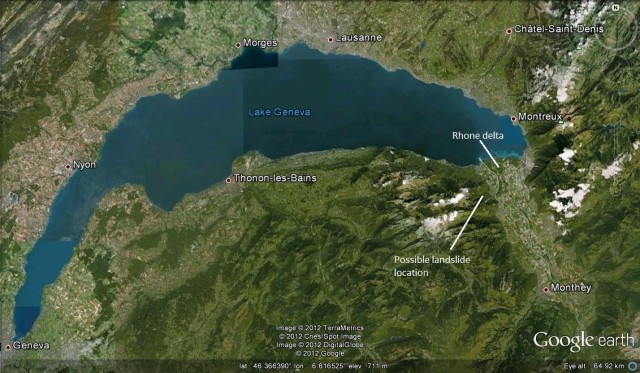30 October 2012
New paper: a historic landslide-induced tsunami in Lake Geneva
Posted by Dave Petley
![]() A fascinating paper as just been published online in Nature Geoscience, detailing a geophysical investigation of a tsunami deposit in Lake Geneva. There are two accounts of a tsunami event affecting the lake in 563 AD; the wave is reported to have inundated much of the ancient city of Geneva, suggesting that it was sufficiently large to overtop the city walls. Several villages along the length of the lake were destroyed. There are no reports that the tsunami was preceded by an earthquake, suggesting that a landslide was likely to have been the cause.
A fascinating paper as just been published online in Nature Geoscience, detailing a geophysical investigation of a tsunami deposit in Lake Geneva. There are two accounts of a tsunami event affecting the lake in 563 AD; the wave is reported to have inundated much of the ancient city of Geneva, suggesting that it was sufficiently large to overtop the city walls. Several villages along the length of the lake were destroyed. There are no reports that the tsunami was preceded by an earthquake, suggesting that a landslide was likely to have been the cause.
The proposal in the paper is that a rockslide triggered destabilization of the Rhone delta deposits at the far end of the lake (more than 70 km from the city), generating a destructive tsunami. The location of the major cities along the banks of Lake Geneva, the subaerial part of the Rhone Delta and the possible landslide scar are shown on the Google Earth image below:
The location of the landslide is suggested to be above the Rhone Delta on the east side of the valley, indicating that the rockslide did not directly enter the lake. The Google Earth perspective view below shows the proposed landslide scar above the modern day village of Le Bouveret). It is certainly credible that this is a large rockslide scar. If the failure was a single event then this would have been a very large landslide:
The study (Kremer et al. 2012) used a large-scale seismic reflection survey to investigate the sediments on the bed of the deep part of the lake, backed up with cores obtained from the lake bed. They found a huge mass movement deposit in the deep lake basin, extending over a length of 10 km and a width of 5 km, and with an average thickness of about 5 m. The authors have interpreted this as being a turbidite deposit typical of that associated with the collapse of a delta. The deposit was radiocarbon dated, giving a result that indicates that it was probably associated with the 563 AD event.
Kremer et al. (2012) have then used this sedimentary evidence to constrain a shallow water model of the tsunami event. The results are shown in the map below from the paper, where the numbers on the banks are the modelled tsunami heights and the red lines and numbers indicate the time taken for the tsunami to reach that point:
Thus, the tsunami reached the site of the modern-day city of Lausanne in 15 minutes and was 13 m high. Even Geneva, now a city of over 200,000 people, was struck by a wave 8 m high just an hour after the initial collapse.
Clearly, a modern-day repeat of this disaster would be catastrophic, with thousands of deaths and huge economic damage. The chances are of course likely to be low, but with such high consequence they cannot be ignored. Kremer et al. (2012) note that their seismic reflection profile indicates several earlier tsunami deposits in the bed of the lake, indicating that this event was not unique by any means. Given that these deposits are likely to have occurred since the last glaciation (when the glaciers would have removed the sediment), the return period is perhaps significant in human term. On that basis it is reasonable to hypothesise that at some very unknown point in the future, there could to be a repeat event. This may not be for hundreds or even thousands of years of course, so there is no real cause for immediate alarm. Protecting settlements against this type of hazard is exceptionally difficult – the amenity value of a lakeside location is so high that it counterbalances the hazard, and it is not possible to build protective structures without seriously reducing the value of the location. A warning system, with clear evacuation plans, is likely to be the optimum mitigation. However, as Kremer et al. (2012) note “We believe that the risk associated with tsunamis in lakes is currently underestimated, and that these phenomena require greater attention if future catastrophes are to be avoided”. It would be sensible to assess properly the hazards pose by the rock masses above the delta, and to evaluate the stability of the sediment pile itself, and to put in place an emergency plan for the lakeside areas if appropriate.
Reference
Kremer, K., Simpson, G., & Girardclos, S. (2012). Giant Lake Geneva tsunami in AD 563 Nature Geoscience DOI: 10.1038/ngeo1618





 Dave Petley is the Vice-Chancellor of the University of Hull in the United Kingdom. His blog provides commentary and analysis of landslide events occurring worldwide, including the landslides themselves, latest research, and conferences and meetings.
Dave Petley is the Vice-Chancellor of the University of Hull in the United Kingdom. His blog provides commentary and analysis of landslide events occurring worldwide, including the landslides themselves, latest research, and conferences and meetings.